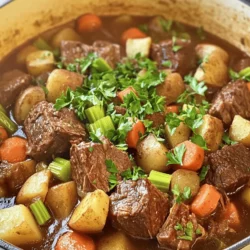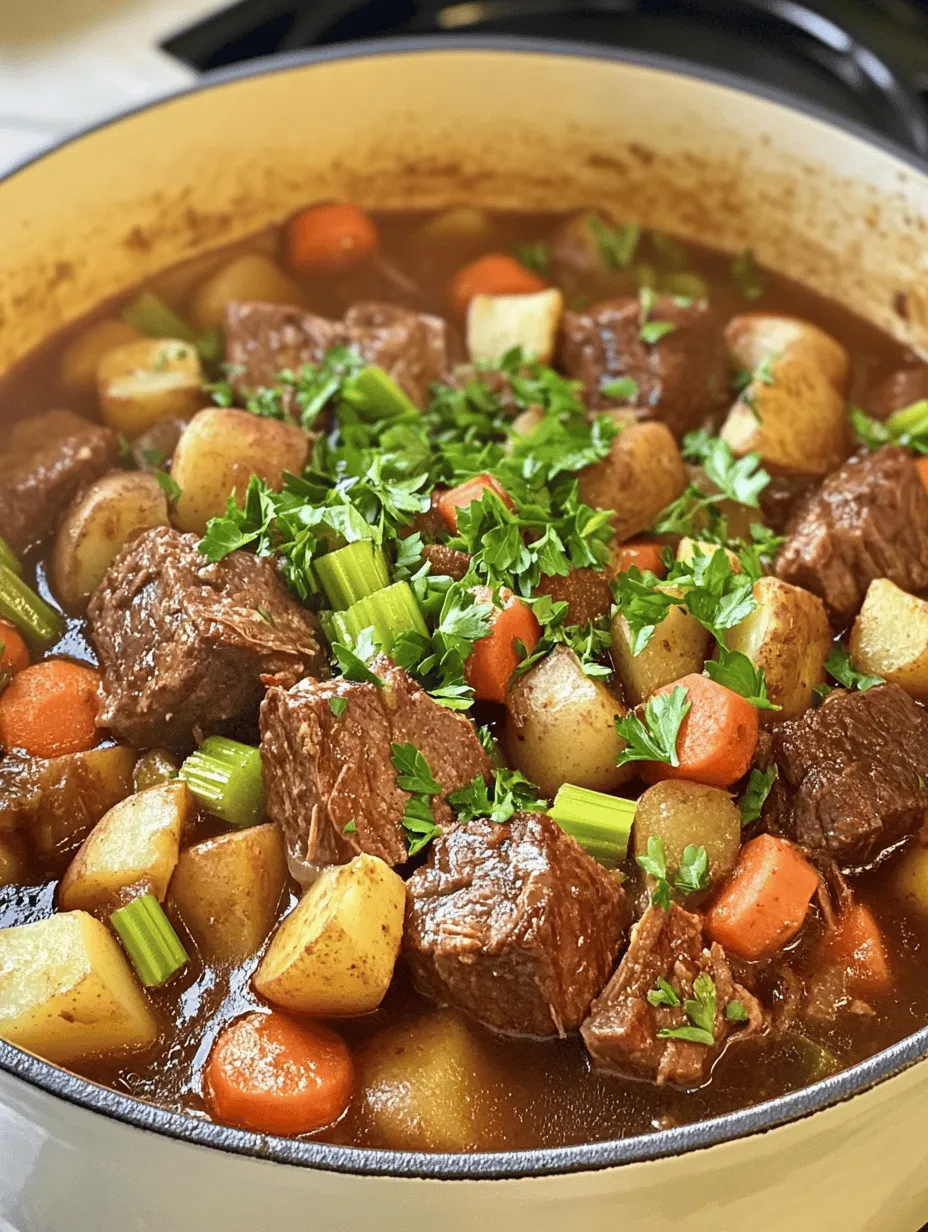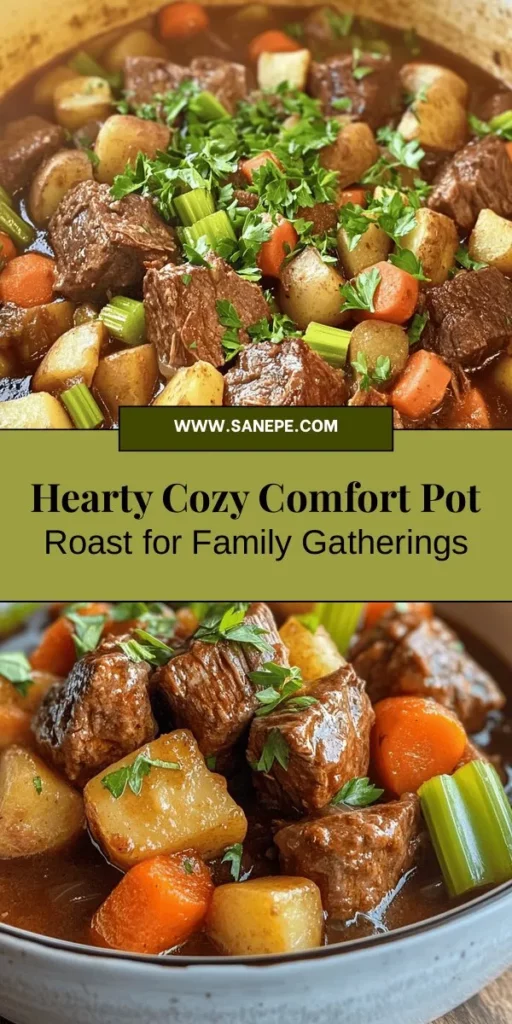Introduction
Pot roast is a beloved classic that has warmed the hearts and bellies of families for generations. This hearty dish is synonymous with comfort food, often evoking fond memories of family gatherings, cozy evenings by the fireplace, and the tantalizing aroma that fills the kitchen as it simmers. What makes pot roast truly special is its ability to transform a simple cut of meat into a tender, flavorful masterpiece through slow cooking.
When it comes to creating the perfect pot roast, the quality of your ingredients plays a pivotal role. Using fresh, high-quality vegetables and a well-marbled cut of meat can elevate the dish from ordinary to extraordinary. The Cozy Comfort Pot Roast recipe is designed not only to satisfy your hunger but also to provide an easy preparation process that yields delicious, satisfying results. With its straightforward approach, this recipe is perfect for both novice cooks and seasoned chefs looking to bring a classic dish to the dinner table.
Understanding Pot Roast
The history of pot roast can be traced back to American cuisine, where it has become a staple in many households. Traditionally, pot roast was a practical way to prepare tougher cuts of meat, allowing them to become tender through slow cooking methods. The concept of braising, which involves cooking meat in liquid over low heat, has roots in various cultures, but it was in America that pot roast truly flourished as a family meal.
The quintessential cut of meat for pot roast is the beef chuck roast, prized for its rich flavor and tenderness when cooked low and slow. This cut comes from the shoulder area of the cow and contains a good amount of connective tissue, which breaks down during the cooking process, rendering the meat succulent and flavorful. While beef chuck roast is the most common choice, other cuts like brisket or round can also be used, depending on personal preference.
One of the many appealing aspects of pot roast is its versatility. It can be served with a variety of sides, from creamy mashed potatoes to crusty bread for soaking up the sauce. The dish can also be customized with different seasonings and vegetables, making it adaptable to any palate or dietary need. Whether enjoyed on a chilly winter evening or at a festive family gathering, pot roast remains a comforting and satisfying centerpiece that brings people together.
Essential Ingredients for Cozy Comfort Pot Roast
To create a truly delightful Cozy Comfort Pot Roast, it’s essential to gather the right ingredients. Each component contributes to the overall depth of flavor and texture of the dish, ensuring that every bite is a taste of comfort.
Beef Chuck Roast
The star of the show is undoubtedly the beef chuck roast. This cut of meat is known for its marbling, which provides flavor and moisture during the cooking process. When selecting your beef, look for a roast that has a good amount of fat running through it, as this will enhance the tenderness of the final product. A well-cooked chuck roast should easily shred with a fork, making it perfect for serving alongside vegetables.
Olive Oil
Olive oil is an essential ingredient in this recipe, primarily used for searing the meat. The fat in the oil helps achieve a beautiful brown crust on the roast, which adds depth of flavor to the dish. Additionally, olive oil is a healthier fat choice, providing heart-healthy benefits compared to other oils.
Vegetables
A classic pot roast is incomplete without a medley of vegetables that enhance its flavor. In this Cozy Comfort Pot Roast recipe, we use:
– Onions: These provide a sweet and savory base flavor. When cooked, they become soft and caramelized, adding richness to the dish.
– Garlic: Freshly minced garlic adds aromatic depth and complements the beef beautifully.
– Carrots: Sweet and tender, carrots not only contribute flavor but also vibrant color to the dish.
– Potatoes: Russet or Yukon Gold potatoes are excellent choices for pot roast. They absorb the savory juices and become creamy when cooked.
– Celery: Adding celery enhances the overall flavor profile with its slight earthiness and crunch.
These vegetables not only lend their flavors to the pot roast but also provide nutritional benefits, including vitamins, minerals, and fiber.
Broths and Seasonings
A flavorful broth is crucial for creating a rich sauce that ties all the elements together. Beef broth serves as the base for this recipe, infusing the meat and vegetables with additional flavor. Worcestershire sauce is another key ingredient, adding complexity and umami notes that elevate the dish.
Fresh or dried herbs such as thyme and rosemary are also essential for enhancing the flavor. These herbs impart a fragrant aroma that complements the meat and vegetables perfectly.
For those with dietary preferences or restrictions, there are a few ingredient substitutions that can be made. For instance, gluten-free beef broth is widely available for those avoiding gluten. Additionally, you can substitute different vegetables depending on what you have on hand or your family’s preferences, such as parsnips or turnips.
Step-by-Step Instructions for Perfect Pot Roast
Now that you have gathered all the essential ingredients, it’s time to dive into the step-by-step instructions for preparing your Cozy Comfort Pot Roast. Following these guidelines will ensure a deliciously tender and flavorful meal.
Preparation of the Roast
1. Drying and Seasoning the Meat: Begin by patting the beef chuck roast dry with paper towels. This step is crucial as it helps achieve a good sear. Once dry, generously season the roast with kosher salt and freshly cracked black pepper. This not only enhances flavor but also aids in forming a crust during searing.
2. Searing the Meat: In a large, heavy-bottomed pot or Dutch oven, heat a few tablespoons of olive oil over medium-high heat. When the oil is hot, carefully place the seasoned roast in the pot. Allow it to sear without moving it for about 4-5 minutes, or until a golden brown crust forms. Turn the roast and repeat on all sides. This step is vital for developing a rich flavor base for your pot roast.
Sautéing Vegetables
After the roast is beautifully browned, it’s time to add the vegetables. Remove the roast from the pot and set it aside on a plate. In the same pot, add a bit more olive oil if necessary, and toss in the chopped onions and minced garlic. Sauté for 2-3 minutes, allowing the onions to soften and the garlic to become fragrant.
Next, add the carrots, potatoes, and celery, cooking them for an additional 5-7 minutes. This sautéing process helps to develop the flavors of the vegetables, creating a delicious foundation for the pot roast.
Once the vegetables are tender, return the seared roast to the pot, nestling it among the vegetables. This step is where the magic begins, as the roast will continue to cook and absorb all the wonderful flavors from the broth and veggies.
Now that you have laid the groundwork for a perfect pot roast, you are well on your way to creating a dish that will become a cherished family favorite. Please follow along for the remaining steps to complete this satisfying meal.

Layering Flavors Through Sautéing
One of the secrets to achieving a deeply satisfying pot roast lies in the art of layering flavors. Sautéing the vegetables and browning the meat before the slow cooking stage is an essential step that enhances the overall taste of the dish. When you sauté, you encourage the Maillard reaction, which creates those rich, complex flavors that make your pot roast truly unforgettable.
Begin by heating oil in your pot over medium-high heat, and add your cut of meat. Sear it on all sides until a golden-brown crust forms. This initial caramelization not only seals in the juices but also forms a flavorful base for your dish. After browning the meat, remove it from the pot and set it aside. Next, add chopped onions, garlic, and other vegetables to the pot, scraping up any browned bits left from the meat. This process, known as deglazing, is crucial because it incorporates the concentrated flavors into your pot roast, enriching the final outcome.
Deglazing the Pot
Once you’ve sautéed your vegetables, it’s time to deglaze the pot. This step is vital in elevating the dish’s flavor profile. As you add in a splash of broth, wine, or even water, be sure to scrape the bottom of the pot with a wooden spoon. The goal here is to lift those flavorful brown bits—fond—into the liquid. This not only adds depth to your cooking liquid but also ensures that every bite of your pot roast is infused with robust flavor. Allow the liquid to simmer for a few minutes, letting it reduce slightly before moving on to the next step.
Combining Ingredients
With the pot deglazed and the flavors developed, it’s time to bring everything together. Return the browned roast to the pot and arrange your sautéed vegetables around it. This careful layering ensures that everything cooks evenly. If you’re using root vegetables like carrots and potatoes, cut them into uniform sizes to promote even cooking. Pour in the remaining broth or cooking liquid, ensuring that the meat is partially submerged, which helps maintain moisture throughout the cooking process. Cover the pot with a lid to trap the steam and heat, making sure to set it to the appropriate cooking method.
Slow Cooking Methods
When it comes to slow cooking pot roast, you have two popular methods: stovetop and slow cooker. The stovetop method allows for more control over the cooking temperature, but it requires more attention to ensure that the heat is maintained at the right level. Generally, a stovetop pot roast will take about 3 to 4 hours on low heat, depending on the size of your roast.
Alternatively, using a slow cooker offers a more hands-off approach. Simply set your ingredients in the slow cooker, cover, and let it do the work. A slow cooker pot roast typically cooks for 6 to 8 hours on low or 3 to 4 hours on high. Both methods yield deliciously tender results, but the slow cooker is ideal for those who prefer to set it and forget it.
Cooking Techniques for a Tender Roast
The key to a tender pot roast lies in the low and slow cooking technique. The slow cooking process breaks down the connective tissues in the meat, transforming it from tough to tender, so patience is essential. To ensure optimal doneness, use a meat thermometer. The ideal internal temperature for pot roast is around 190-205°F (88-96°C), which indicates that the collagen has melted, resulting in a juicy and fork-tender roast.
While cooking, keep an eye on the moisture level. If you notice that the liquid is evaporating too quickly, you can add a bit more broth or water to maintain the right balance. It’s important to avoid opening the lid frequently, as this releases heat and can extend cooking time. Instead, check for doneness near the end of the cooking period.
Signs to Look for to Determine Doneness
To determine whether your pot roast is done, look for the meat to have a dark, caramelized exterior and a tender texture that easily shreds apart with a fork. The vegetables should be soft but not mushy, retaining their shape and flavor. If the meat still feels tough, give it additional time, checking every 30 minutes until it reaches that perfect level of tenderness.
Tips for Maintaining Moisture and Flavor During Cooking
To keep your pot roast tender and flavorful, consider these tips:
– Use a tight-fitting lid: This helps to trap the moisture, preventing the meat from drying out.
– Avoid high heat: Cooking on low heat allows the meat to cook evenly, reducing the chances of it becoming tough.
– Add vegetables at the right time: If using delicate vegetables such as mushrooms or zucchini, add them in the last hour of cooking to avoid overcooking.
Serving Suggestions and Pairings
Once your Cozy Comfort Pot Roast is done, it’s time to serve it up! Pairing your pot roast with complementary side dishes can create a well-rounded meal. Here are some ideas:
– Crusty Bread: A loaf of fresh, crusty bread is perfect for soaking up the delicious gravy.
– Salad: A light green salad with a tangy vinaigrette can provide a refreshing contrast to the richness of the roast.
– Mashed Potatoes: For a comforting twist, serve your pot roast over creamy mashed potatoes, allowing the gravy to pour over both.
Presentation Tips for Serving Pot Roast Attractively
When it comes to serving your pot roast, presentation can elevate the meal. Slice the roast into thick pieces and arrange them on a large platter with the vegetables artfully arranged around it. Drizzle with the cooking liquid or gravy for an inviting look. Garnish with fresh herbs like parsley or thyme for a pop of color. Don’t forget to provide a ladle for the gravy so guests can help themselves!
Storing and Reheating Leftovers
After enjoying your pot roast, you may find yourself with delicious leftovers. To store them properly, allow the pot roast to cool completely before transferring it to an airtight container. It can be refrigerated for up to 3-4 days or frozen for up to 3 months. If freezing, consider portioning it out for convenient meals later.
How to Properly Reheat Without Losing Flavor and Texture
When it comes to reheating, aim to preserve the moisture and texture of the meat. The best method is to reheat in a pot on the stove over low heat. Add a splash of broth or water to ensure it doesn’t dry out. Stir occasionally until heated through. Alternatively, you can use a microwave, but be cautious not to overcook it, which can lead to toughness.
Ideas for Using Leftover Pot Roast in New Dishes
Leftover pot roast is incredibly versatile. Here are a few creative ideas:
– Sandwiches: Shred the meat and serve on crusty rolls with horseradish or barbecue sauce.
– Casseroles: Chop the roast and mix it into a casserole with vegetables, cheese, and a creamy sauce.
– Tacos: Use the shredded meat as a filling for soft or hard taco shells, topped with your favorite salsa and avocado.
Conclusion
The Cozy Comfort Pot Roast is more than just a meal; it’s a celebration of warmth and togetherness. This classic dish has a timeless appeal, bringing families together around the dinner table for heartfelt conversations and shared memories. The satisfaction of creating a homemade pot roast, with its richly layered flavors and tender meat, makes it a cherished recipe in kitchens across the world. Whether it’s a chilly evening or a festive gathering, pot roast is always a comforting choice that warms both the belly and the heart. So gather your loved ones, serve up a hearty portion, and relish in the joy that this dish brings.


